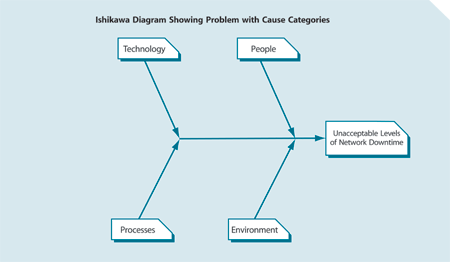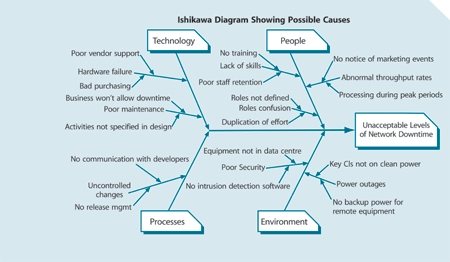
CATEGORIES:
BiologyChemistryConstructionCultureEcologyEconomyElectronicsFinanceGeographyHistoryInformaticsLawMathematicsMechanicsMedicineOtherPedagogyPhilosophyPhysicsPolicyPsychologySociologySportTourism
C5 Verifying the true cause
The remaining possible causes have to be verified as being the source of the problem. This can only be done by proving this in one way or another – for example by implementing a change or replacing a part. Address the possible causes that can be verified quickly and simply first
Appendix D: Ishikawa Diagrams
The Ishikawa Diagram, also known as the Fishbone, Cause-and-Effect or Tree Diagram, is a tool used for systematically identifying and presenting all the possible causes of a particular problem on a chart. The technique is named after its developer, Kaoru Ishikawa (1915–89), a leader in Japanese quality control. An example is shown below.
The main goal is represented by the spine or trunk of the diagram and primary factors are represented as branches. Secondary factors are then added as stems, and so on. Creating the diagram stimulates discussion and often leads to increased understanding of a complex problem. These diagrams are extensively used in identifying solutions to systemic problems, such as identifying the cause of productivity loss on assembly lines, or lower customer satisfaction levels in a service organization.
The basic technique of developing these diagrams, together with a very simple example, is shown here. A problem solving team will use the Ishikawa Diagram as follows:
- 1.- Prepare a blank diagram in a format that can be viewed by the entire group. This could be a flipchart, board, projected through a data projector from a PC, etc.
- 2.- Define the problem that the group is trying to solve in clear and specific terms and write it in the box at the ‘fish head’ box of the diagram.
- 3.- Write the cause categories into the tips of the ‘fish bones’. These should be fairly broad categories as the exact causes are not yet known. An example is shown in Figure D.1 in which the group is trying to find the cause for unacceptable levels of network downtime.

Figure D.1 Sample of starting an Ishikawa Diagram
- 4.-Use brainstorming techniques to get participants to suggest possible causes, and note these on the relevant branch of the diagram. A simple diagram has been completed in Figure D.2.

Figure D.2 Sample of a completed Ishikawa Diagram
- 5.- Interpret the diagram. This could be done by ranking the top causes based on experience and available data. Once the top causes have been selected, each one will be investigated further according to its rank and priority
Appendix E: Detailed description of Facilities Management
The purpose of this appendix is not to provide a detailed explanation of all aspects of Facilities Management. Rather, it will highlight the most important activities to assist in positioning some of the other functions and in identifying where specific processes impact on good Facilities Management and vice versa.
Facilities Management will provide information to Configuration Management regarding the location and status of CIs, and will also be an integral part of Change Management, Capacity and Availability Planning and Service Continuity Management.
The main components of Facilities Management are as follows
Date: 2014-12-29; view: 1906
| <== previous page | | | next page ==> |
| C1 Defining the problem | | | E2 Equipment Hosting |